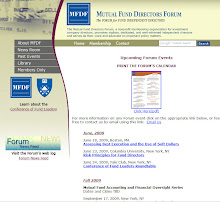On April 17, Andrew J. Donohue, Director of the SEC's Division of Investment Management, addressed the American Bar Association's spring meeting in Vancouver. His speech, entitled "Investment Company Act of 1940: Regulatory Gap between Paradigm and Reality," discussed "investment companies' use of derivatives and what [Donohue] perceive[s] as the increasing gap between how the Investment Company Act of 1940 and investors look at fund portfolios versus how investment advisers look at them."
In particular Donohue stressed his concern about "the accompanying leverage that derivatives give to mutual funds." After a fairly succinct discussion of the purpose and history of Section 18 of the 1940 Act -- which the Commission has interpreted as limiting funds' ability to use leverage and has been interpreted to address aspects of fund exposure to derivatives positions -- Donohue reminded his audience that the fund's management and board of directors bear primary responsibility for monitoring how use of derivatives and other complex investment instruments affect the fund's portfolio, and how the corresponding risks of these instruments are disclosed to shareholders.
Donohue discussed how, given the increased use of derivatives by funds, he had reviewed SAI disclosures describing the risks of using derivatives to determine whether "funds have engaged in improved risk disclosures to address leverage concerns." He found that the disclosures for most part met the disclosure requirements of the 1940 Act:
Donohue continued by challenging the group to address his concerns:

In particular Donohue stressed his concern about "the accompanying leverage that derivatives give to mutual funds." After a fairly succinct discussion of the purpose and history of Section 18 of the 1940 Act -- which the Commission has interpreted as limiting funds' ability to use leverage and has been interpreted to address aspects of fund exposure to derivatives positions -- Donohue reminded his audience that the fund's management and board of directors bear primary responsibility for monitoring how use of derivatives and other complex investment instruments affect the fund's portfolio, and how the corresponding risks of these instruments are disclosed to shareholders.
While acknowledging its critical role in enhancing investor protection,the Commission noted in ten-triple-six that the responsibility for managing an investment company's investments fall, in the first instance, on the fund's management and board of directors. The Commission cautioned fund directors to consider the "potential loss of flexibility" when determining the extent to which funds engage in leveraged transactions. Moreover, the Commission suggested that directors should review a fund's disclosure documents to "ensure complete disclosure," including:
1) the potential risk of loss;
2) the identification of the securities trading practices as separate and distinct from the underlying securities;
3) the differing investment goals inherent in participating in the securities trading practices versus investing in the underlying securities;
4) whether the fund's name accurately reflects its portfolio investment policies and securities trading practices; and
5) any other material information relating to such trading practices.
Donohue discussed how, given the increased use of derivatives by funds, he had reviewed SAI disclosures describing the risks of using derivatives to determine whether "funds have engaged in improved risk disclosures to address leverage concerns." He found that the disclosures for most part met the disclosure requirements of the 1940 Act:
- A mutual fund investing in derivatives must comply with the fund's name as required by Section 35(d);
- A fund's derivative transactions must be consistent with its investment objectives and policies set forth in the fund's registration statement.
- Consistent with ten-triple-six and its progeny, for purposes of Section 18 of the '40 Act a fund engaging in trading practices involving derivatives and leverage should cover its position with segregated assets or an offsetting hedge; and
- A fund's portfolio must meet stringent diversification and liquidity standards.
Donohue continued by challenging the group to address his concerns:
Broadly speaking, here are three concerns regarding investment companies' use of derivatives for your consideration:He concluded by requesting input from his audience and the industry about some fundamentals of the application of the 1940 Act to funds' use of derivatives:
- Funds should have a means to deal effectively with derivatives outside of disclosure;
- A fund's approach to leverage should address both implicit and explicit leverage; and
- A fund should address diversification from investment exposures taken on versus the amount of money invested.
- Should the application of '40 Act leverage restrictions to derivatives held by investment companies be re-examined?
- Is the thirty year patchwork of stated Commission policy and staff positions regarding investment companies' use of derivatives sufficient or is regulatory and/or legislative action necessary to address the leverage created by investment companies' use of derivatives?
- If you believe action is necessary, what do you recommend?
- Do existing rules sufficiently address matters such as the proper procedure for investment company pricing and liquidity determinations of derivatives holdings?
- Are investment company boards exercising meaningful oversight of funds' use of derivatives, including risk management, proper accounting and internal controls?






